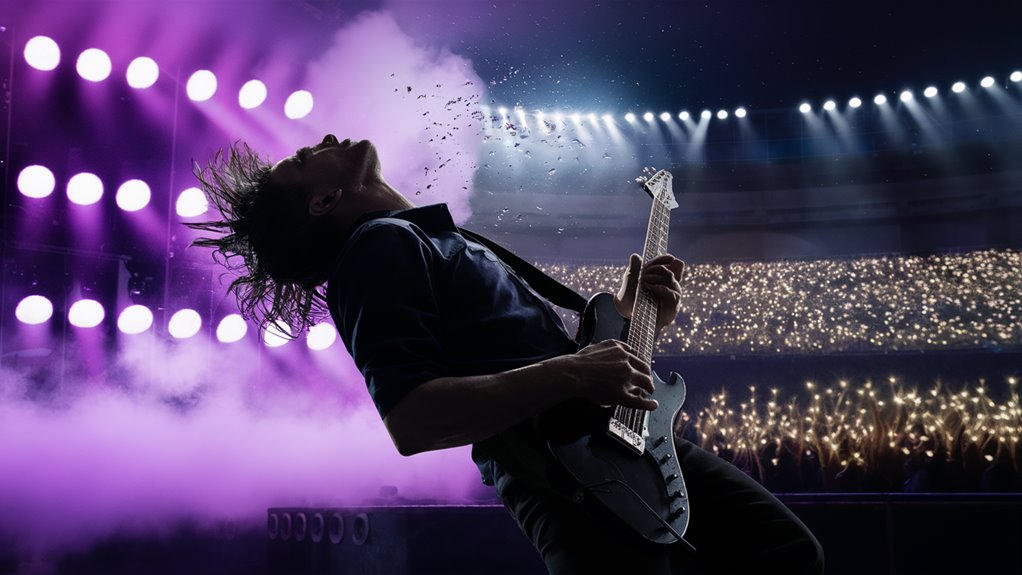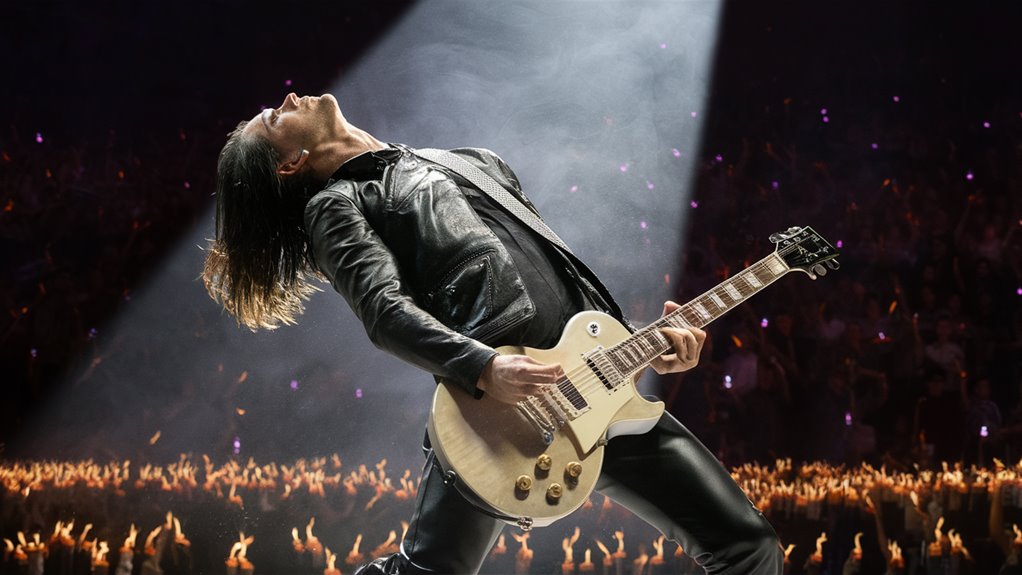
Top Rock Ballads That Impress the Fans

Making great rock ballads is about nailing the mix of sound and heart. Hits like Poison’s “Every Rose Has Its Thorn,” Metallica’s “Nothing Else Matters,” and Def Leppard’s “Love Bites” show what gets fans behind songs the world over.
What Makes Iconic Rock Ballads
They start with a soft piano or guitar beginning, pulling in the crowd fast. Simple verses add room for the story to build to a big chorus that you feel everywhere. Sudden key changes and loud-to-soft shifts guide us to an ending that hits hard, leaving all in awe.
Mastery in the Music
These top songs show off top singing skills like:
- Strong high notes
- Clear vibrato
- Deep voice mixes
- Perfect Karaoke Experience
- From quiet verses to loud choruses
Focusing on these key music bits, the songs make a strong feeling link with the crowd. This way of making music keeps affecting today’s rock songs, showing why these tracks are key for great shows.
Power Ballads On Top
The Rise of Power Ballads: A Full Look
How They Began
Power ballads took the mid-1970s rock world by storm, changing how emotion was part of pop tunes.
The mix of hard rock and real feelings set a new bar for songs.
Breakdown of a Power Ballad
Top power ballads have a tried and true form that’s well known in rock.
With calm song starts, they build up step by step until the big chorus hits hard. Famous groups like Foreigner and Journey got this down to an art, laying the way for others.
Sound Work and Skills
The sound of power ballads needs special studio tricks to pack a punch. Key parts are:
- Wide drum sounds
- Vocal layers
- High guitar solos
- Loud and soft parts
Change and Impact
Big names like Bon Jovi and Whitesnake took the style up a notch with smart making and writing of tunes.
Their hits turned these love songs into big arena anthems that still shape music now. With clever playing of instruments and peak moments, they made songs that stick in hearts and minds.
What Makes Rock Ballads Stick
Key Parts of Rock Ballads
The Art of Starting
Rock ballads usually kick off with a soft musical tune, using clean electric guitar or piano.
These light starts make a feeling base while verses build up, keeping us waiting for more.
How the Chorus Works
The key chorus is the big part of rock ballads, with more sound, stronger singing, and layered voices that fill the air.
This crucial part turns soft tales into strong shared moments, at the heart of the tune.
Sound in the Studio
Special sound moves shape the rock ballad style with echoing drums, rich guitar play, and careful synth or string bits.
The singing path moves from low-key to powerful held notes.
These tunes use soft and loud shifts well, moving from quiet bits to huges sound bursts that make their mark.
Bridge and More
The bridge part often drops in a deep key switch or a touching guitar solo, pulling at our hearts.
This part lifts the whole song before it wraps up.
Sound Bits in the Mix
Key bits in rock ballads are:
- Clever sound layering
- Big dynamic changes
- Deep voice changes
- Chorus with harmony
- Managed highs and lows
These mix to make the classic rock ballad feel, hitting us right through with the perfect mix of music and feeling.
Top Power Ballads Over Time
Most Impacting Power Ballads Through Years
The Starting Days: 1970s
Power ballads became key in rock during the 1970s. Aerosmith’s “Dream On” (1973) set the standard, moving from soft piano to huge choruses.
Styx’s “Come Sail Away” (1977) took it further, perfecting the shift from calm to heavy that marks the style.
The Big Time: 1980s
The 1980s were the high point for power ballads. Journey’s “Open Arms” (1981) showed off perfect high moments.
Bon Jovi’s “Livin’ on a Prayer” became the big hit, with real-life stories and a big key jump that set new marks for the music.
Whitesnake’s “Is This Love” and Guns N’ Roses’ “November Rain” added fine guitar work and big strings.
Heart’s “Alone” showed the range with strong woman singing, setting new highs for feeling.
The Shifts: 1990s
The 1990s saw power ballads change with new sounds. Aerosmith’s “I Don’t Want to Miss a Thing” is a top show of this, keeping deep feelings but with big film-like sound.
This shift showed how classic ways can keep up with new studio moves but keep their strong points too.
The Story of the Hits
The Making of Hit Power Ballads: The Song’s Way

How Iconic Tunes Came to Be
Power ballads have shaped big rock scenes, more from deep personal times than just aiming for hits.
Journey’s “Open Arms” is a top example of tunes changing, from a small piano piece to a big crowd song with help from key guitar bits and some starting troubles.
Famous Starts and Changes
Aerosmith’s “Dream On” was a big point in rock as Steven Tyler’s first song try, on piano as a young guy.
Year by year, it got better, turning into a rock must-have.
Guns N’ Roses’ “November Rain” started big at the piano, then got made just right for all to hear.
Twists in the Making
The big ballads shifts often came as a shock.
Bon Jovi’s “I’ll Be There for You” started fast, then Richie Sambora’s guitar change made it new. These big shifts show how new tries and team work shape the big hits that mark times.
How the Sound Grew
- Piano tunes became guitar blasts
- Studio tries led to new mixes
- Work within the group polished it all
- Acoustic bits change the final look
How to Nail a Power Ballad
How to Sing Power Ballads: Pro Moves and Tips
Getting the Sound Just Right
Playing with sound is key to getting a ballad right. Start low and slow to build the feel, then let it all out in the chorus.
Good breath work is a must for keeping up those big notes.
How to Hold the Mic
Right mic use really helps in how a ballad sounds. Keep it far in loud parts but close in the soft spots.
Playing with vibrato – light in verses, more in high spots.
Clear sound on each word is key, so it does not get lost when it’s loud.
Moves for Singing
Standing right and moving right lift a ballad up. Feet set wide in big parts and let your body sway with the tune.
Keep your power for the big end, not all at once. This way, the song keeps strong all through to a big last part.
Pro Tips:
- Work on breath for long high notes
- Get the mic just right
- Make vibrato work for you
- Keep words clear
- Stand strong
- Watch your song power
Making a Hit Ballad
How to Write a Top Power Ballad: All You Need
How to Build It
Writing a power ballad means knowing what makes one work deep down.
Here’s how proven steps make songs that stay with people.
Set the Scene with Verses
A good bare verse sets the tone. Start with just a piano or guitar, leaving room for vulnerable words.
The lead-up part adds in tension with:
- Going up tunes
- 호치민 퍼블릭가라오케
- Adding more sounds bit by bit
- More and more music bits
Nail the Chorus
Big singing lines and smart chord moves lift it all up. Here’s what you need:
- Strong chords
- Waiting to resolve the sound
- Big tune endings
Build and Top It Off
The bridge part needs fresh tunes but sticks to the main feel. Key bits are:
- Opposite music bits
- Tunes that match well
- Music that builds up
The Big Ending and Sounds
Use these top moves for the biggest hit:
- Key jumps for deep feels
- Voice layers that fit
- Lead guitar for breaks
- Sound mix that builds
- Big music surges
These build steps make the perfect power ballad that touches us all and lasts forever.


